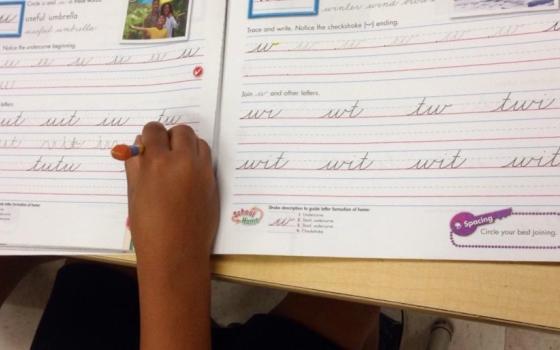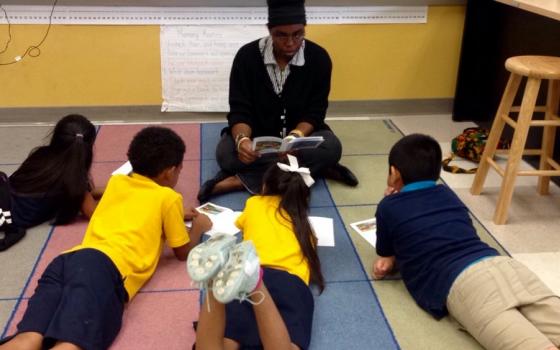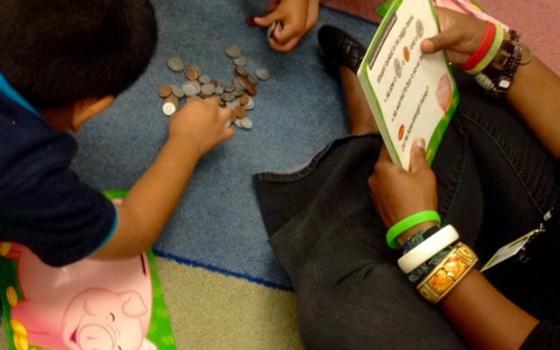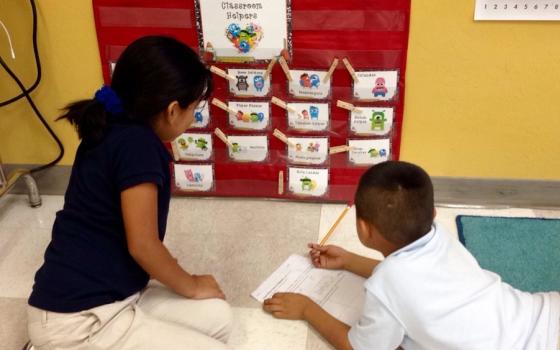Notes from the Field are reports from young women volunteering in ministries of Catholic sisters. The project began in the summer of 2015 when, working with the Catholic Volunteer Network, we enlisted four young women working in Honduras, Thailand, Ethiopia and the United States to blog about their experiences. The fall series presents two more women, both volunteering with sisters' ministries in the United States.
______
Adan likes to drink three chocolate milks each day at supper at the Guadalupe After-school Program. When there is chicken for supper, Alyssa eats the skin first because that is her favorite part. Mario has a difficult time focusing on his homework, but there is no other thing he would rather do than to write in cursive or play football.
I was unsure what my role was going to be at the Guadalupe After-school Program other that I was going to be the teacher. On my first day, like every first day, things were a little bit hectic and disorganized. All the high school volunteers and teachers were busy making sure their lesson plans were well written and that supper was on table for when the students came through the door.
I had a variety of emotions on the first day. I was very nervous and enthusiastic at the same time because I had never worked with elementary-school kids before. While in college, I had been a middle school mentor twice a week, helping at-risk students with their math, English and Spanish homework. Middle school can be a challenging time for some students because they are starting to learn who they are as people and beginning to establish their identities.
I came into my first day of the after-school program thinking that, since my students were second-graders, they would be a lot more obedient and willing to listen to me than middle-schoolers. This was true for the first three weeks of the program. Everything I said and asked them to do, they would do willingly and without hesitation.
"Can you hold the door, please?" Yes.
"The quietest table gets a point" — which usually meant I gave all four tables a point. The 15 students were just starting to get comfortable with me as their after-school teacher. All their insecurities and inner personalities were hidden.
It is now two months into the after-school program, and my kids for the most part are still obedient and well-behaved. Every aspect is the same except that I have begun to establish trust among each student. Not only trust — a daily routine. Routine is good for them because it teaches them discipline. Children's fear of the unknown includes everything from a suspicious new vegetable to major changes in their lives.
The unknown in this case is the Guadalupe After-school Program itself. Even though some of the students are returning from the previous school year, there are still a lot of students who are new here.
This is why I made it my priority to have a structure and a routine for the class to teach kids how to constructively control themselves and their environment. As I mentioned in my last blog post, most of the students in the program live in a low-income household.
Before starting the program, all of the teachers and high school volunteers had a four-day orientation. There, I had the opportunity to interact with each of the three program coordinators. I learned from them that in the students' homes, there is no set time or sometimes space to do homework. This is because their parents are busy working at their second or third job. Students don't learn how to sit themselves down to accomplish a task. The students who don't develop self-care routines, be they grooming or homework, may find it hard to take care of themselves as young adults.
As the kids start trickling into the cafeteria at 2:50 p.m., they know exactly what to do. They have approximately 10 minutes to eat their supper. Afterward, I take them to the playground for 25 minutes for them to release some of that high energy. We finally make to the classroom at 3:40 p.m. My students have 20 minutes to finish homework. They then get split into three centers: writing/vocabulary, reading, and math. We rotate every 15 minutes, so by 4:45 p.m., they have had a chance to participate in all three centers.
Each center is led by my high school volunteers, who do an activity with the students. In the writing/vocabulary center, the students often create a journal entry. In the reading center, the students read a book then complete a reading-comprehension worksheet. My second-grade students are learning how to add and subtract, so in the math center, we do activities that reinforce the topics they are learning. This type of class structure has helped my students internalize constructive habits.
Even though I have been volunteering with the program for only two months, I have already seen some subtle changes in the students' habits. As soon as they enter the classroom, they automatically take a seat and start on their homework without me telling them. When it is time to rotate centers, they know what to do and where to go.
You may ask: Won't too much structure dull the students' sense of spontaneity and creativity? Sure, if it's imposed without sensitivity. I always try to plan my lessons based on what the interests of my students are while still making the learning experience a good one.
Mario is a great example. Mario likes to write in cursive, so whenever he is in the writing center, he writes his answers in cursive, keeping him more engaged with the material. It is also important to note that there is no reason why structure has to be oppressive. I like to think of structure and routine as friends that make life in my class easier and cozier.
Knowing that my students are slowly but surely opening up to me also makes my life cozier. I'm starting to see their personalities shine and come out of the box. This is how I know that Adan likes to drink a lot of chocolate milk, that Alyssa likes the skin of the chicken and that Mario likes to play football. Not only have I begun to see what their strengths and weaknesses are, but I have also started to see what their interests and hobbies are.
This particular aspect of the program has been invigorating. I can't help but think about how we start forming our own unique personalities at a young age. Every little thing that these children think or do has an impact in their life. I like to think they are building a house, and I'm there to guide them. To build the house, you must start from the bottom and work your way up. My students are just beginning to install the bricks. When I'm helping a student how to solve a word problem, I know that if I help them understand how to do it, this small step will help them progress to the next lesson. Metaphorically, they will start adding details to the house, like painting walls or installing furniture.
Just like I'm helping them build their house, they are helping me build my house. In the short amount of time I have spent with them, I have become a more understanding, patient and humble person — characteristics I did not think I had. There are times when certain students decide to act up or not listen. I pull them aside and talk to them. Understanding, humility and patience are characteristics that go a long way in any work setting. I hope to keep enriching my relationship with my students just as they will help enrich mine as the year moves on.
[Sharon Zavala is a Humility of Mary volunteer in Immokalee, Florida. She has a bachelor's degree in environmental studies and Spanish from Allegheny College.]




